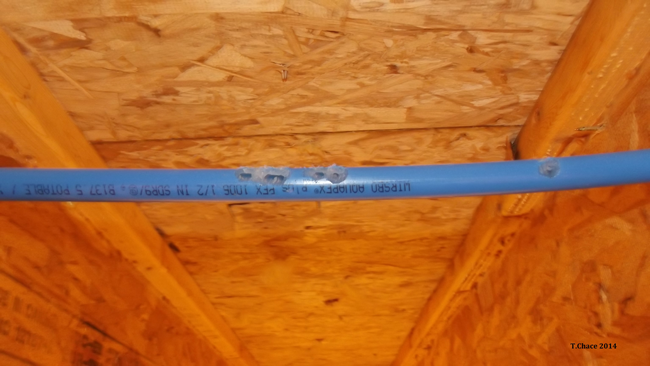The $10,000 Rat: A Case Study from Portsmouth, NH
By Chris Williams on March 10, 2014.

Rat chewing plastic heating pipe in Portsmouth, NH.
It all started in October, 2013. Charlie’s daughter said, “I hear water running in the basement Dad.” Sure enough, upon investigation, water was pouring out of the basement ceiling and flooding the basement. Quick action saved the day.
Charlie shut off the feeder valves that serviced that section of plastic radiant heating pipe, and at least, the flooding was stopped. This being the 3rd year in the newly renovated “flip”, Charlie was finding all sorts of construction issues, including shoddy chimney flashing creating 2nd floor ceiling leaks, unscreened gable vents, and holes in the foundation to name a few.
Now faced with this new water damage in the basement, Charlie called a plumber. While fixing the damaged plastic heating line, the plumber noted what looked like chewing or gnawing marks at the site of the leak. In the same area, rodent droppings and insulation arranged in what could be described as a nest were also found and removed.
The plumber said that this damage could be related to mice or rat activity. No sooner than the next night, another water leak developed, and another. Efforts to isolate the leaks became exhausting, and before long the entire basement sheetrock ceiling had to be taken down. Several “nesting sites” were found along with what I confirmed as rat droppings.
Unfortunately, two pest control firms were called in to control this rat. With no effect, the rat was eventually sealed into the house, and had become leery of traps and bait placements. This was a problem animal, accustomed to the control measures, trapped inside the residence, and continuing to damage the plastic water lines used for heating, and plumbing.
I showed up on the scene in February 2014. Damage was still taking place despite the best efforts of Charlie and two pest control firms. Rustling noises were being heard in the vaulted ceiling of the master bedroom addition, in the plumbing chase for the master bath, and in the wall over the dinning room, below another 2nd floor bathroom.
A positive identification of the droppings confirmed that in fact a single rat was the problem. My estimate was that a small, mature Norway rat, approximately 7-9 inches long, was the culprit. Looking back, the event likely started with the dog. Charlie’s dog is a great old soul, loves kids and howls at new arrivals. Old dogs have poor digestion, and produce excellent rat food when they poop. It appears that when the weather got cold, much of the dog feces was left in the yard. Once a rat finds a food source, and a place to live (hole in foundation under entry platform) life is good.
During my first inspection, I was amazed to see over 50 rat traps set in great spots, several types of over the counter rodenticides placed all over the place, including trays on the floor(never appropriate). Not much could have been added to the massive trapping regime in place, and as it turned out, the rat had recognized the danger associated with the traps anyway.
After some careful thought, I decided that my best option was to get some different bait to the rat where it had been scurrying around in the walls. With Charlie’s help, we were able to cut a hole in the master bedroom ceiling and make a large bait placement. I was also able to get some bait into a plumbing wall below the guest bathroom on the 2nd floor.
When poison bait is used, it usually takes a couple days for the rodent to find and consume a lethal dose. Once feeding on the bait occurs, death comes in 3-5 days. 9 days after my original bait placement all damage and activity ceased. Plumbing repairs were resumed and life returned to normal in short order. Gable vents were screened off to prevent squirrels or other animals from getting into the attic, all dog feces have been removed, and an exterior bait station is attached under the ramp to the shed as a preventative measure.
Although extensive damage to plumbing is uncommon, this case is a good example of what to expect if rats are able to take up residence in your home. I have seen severe wiring damage, insulation damage, damage to furniture, contamination of stored food stuffs, and damage to siding caused from rat activity. The best way combat rats is to keep an eye out for signs of activity: burrows in yard, rodent feces, chewing or gnaw marks on rubbish barrels, and actual sightings. There are over ten rats for every one that is seen in the daytime.
At the first signs of rat infestation, call a Pest Control Professional!